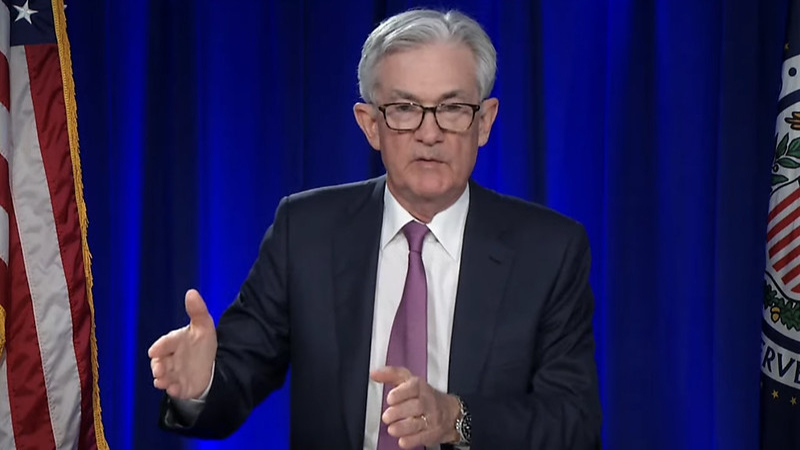The Federal Reserve raised interest rates by an aggressive 75 basis points (bps) last week, bringing the range to 1.5-1.75%. It also changed its policy statement to signal a stronger commitment to bringing inflation back under control.
In the narrow path it is tiptoeing between curbing inflation and inducing recession, it made it clear that inflation is its greater priority. This means some eye-watering rate rises could still be ahead.
Fed chair Jay Powell (pictured) said an increase of 50bps or 75bps was likely at the central bank’s next meeting, scheduled for 26-27 July.
The central bank’s “dot plot” suggests rates will rise to 3.4% by the end of 2022, peaking at 3.8% in 2023. While investors ponder whether the Federal Reserve will remain resolute in the face of a weakening economy, they may be underestimating its determination to tackle rising prices.
In May, Powell said that monetary policy would continue to tighten until there was ‘clear and convincing’ evidence that inflation was decelerating.
Another big commodity shock can’t be ruled out
Against this backdrop, the only factor likely to change the current path for interest rates is a sign that inflation is peaking. There was a brief flurry of excitement around the end of May, as rises in the core personal consumption expenditures index – the Fed’s preferred inflation gauge – showed signs of slowing. Goldman Sachs said at the time this could be a sign that price pressures were easing.
This view seemed to be supported by a small dip in the broader CPI figure in April – from 8.5% to 8.3%. However, any optimism that this marked a peak for US inflation was short lived and it re-accelerated in May.
Richard Carter, head of fixed interest research at Quilter Cheviot, said: “Last month’s drop in inflation in the US was never going to be the start of it freefalling to more palatable levels, and the reading showed just how precarious the situation is with CPI rising 8.6% year-on-year, higher than expected and compared to last month.”
His view is that this will be a protracted peak, with inflation to remain high for some time to come: “Energy prices have the potential to keep rising further as the Ukraine war drags on and once China switches back on following their Covid shutdowns. This is very much a global problem and not going anywhere anytime soon.”
In a recent note, Rathbone agreed there are few signs of easing inflationary pressures. “While we believe inflation is likely to fade back to more normal levels throughout 2023, we think there’s a significant risk that inflation will decline more slowly than widely expected. In particular, we can’t rule out another big commodity supply shock that would keep energy and food inflation high for much longer.”
Inflation is a political decision
That said, there are those who are more optimistic. Luca Paolini, chief strategist at Pictet Asset Management, warns against extrapolating the trend of recent months too far into the future: “What we see now is a cyclical overshoot; we’re not going back to the seventies. […] we expect inflation to go back, slowly, to the level we saw in the financial crisis.”
“When we look at the past year, we have seen the biggest positive surprise in inflation in 40 years. With the benefit of hindsight, we shouldn’t be that surprised. Inflation is a political decision. There has been too much fiscal and monetary stimulus and not enough people physically to produce the stuff that the surge in demand has created.”
This should slowly normalise – demand will naturally fall as stimulus is withdrawn and economies weaken.
Paolini adds: “Productivity is not improving significantly and there is no growth in working age population. Growth is not likely to be very different to before. Digitalisation may increase productivity, but there is no evidence yet.”
Supply may continue to be interrupted by the war in Ukraine, but other sources of supply may emerge and the supply chain disruption associated with the pandemic is easing.
Certainly, this is the view of the Federal Reserve, who believe that while rates will peak at a relatively high 3.8%, they will fall quite rapidly thereafter. This is commensurate with a “softish” landing, says Powell. This view is echoed in bond markets.
Peak inflation remains elusive
In assessing whether inflation is peaking, the Federal Reserve is likely to be looking at consumer inflation expectations and whether they are falling. Any sign that consumers are pulling forward spending in anticipation of higher prices would be very unwelcome.
Supply chains will also be under scrutiny – are they normalising in the wake of the pandemic? Energy prices are also likely to be on the Federal Reserve’s list – are countries starting to bring on new supply either through renewables or alternative sources of fossil fuel?
Wage growth will also be important. The labour market has been strong and competitive, which may create pressures. Governments are acutely conscious of public-sector pay restraint, but faced with unhappy unions and striking workers, their hand may be forced.
There is a plausible set of circumstances – a de-escalation in Ukraine, a resolution in supply chain problems, weakening demand – in which inflation turns relatively quickly.
However, none of those factors are happening today. Peak inflation remains elusive and there is the real danger of another lurch higher when households face higher energy bills in October and beyond.
It would be nice to think that the Federal Reserve is just talking tough before easing off, but there isn’t a lot of evidence for that view. Until there are clear signs that inflation is beaten, investors will need to put up with the volatility created by rising rates.







